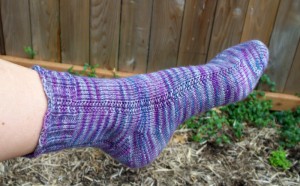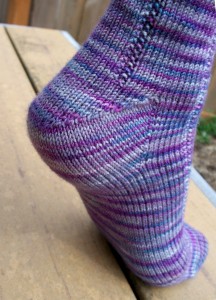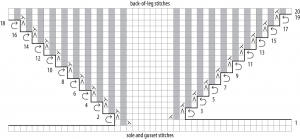Experimental sock
By JC | July 18, 2011
Remember the toe I mentioned in my last post? The one with the kfb increases? It’s turned into a sock:
For the most part, it’s just a plain vanilla sock. The only decorative elements are narrow columns of seed stitch, just two stitches wide, added more to keep me from falling asleep while knitting than for any other reason.
Ah, but the heel—that’s where the real experimentation came in. It’s one of Wendy Johnson’s “gusset heels,” something I’d read about years ago but never gotten around to trying… until now.
And, for me, trying out the heel was essential. Just reading about it didn’t let its construction “sink in” properly. Still, let’s see if I can summarize: For one of these heels, you knit the foot even until you reach the juncture between your foot and your leg… you know, where you get a crease when you bend your foot up. Then you work two gusset increases every other round for a bit. Finally, you work a series of short rows, ending each row with ssk, k1 or p2tog, p1—much like a heel turn on a traditional flap-and-gusset heel—until you’re back to your original stitch count.
In knitting this sock, I wanted to learn two things: How do you know how many gusset increases to work? And how does the heel fit?
As it turns out, I answered the first question not by knitting but by charting the heel turn:
Charting the heel turn let me see that, when you work a bunch of short rows ending with ssk, k1 or p2tog, p1, you’ll decrease away half your stitches—but in the first two rows, you work even over several stitches at the center of the heel. So over the course of the short rows, you’ll lose not quite half your sole and gusset stitches. Specifically, subtract 8 from the number of sole stitches—that’s the number of stitches you’ll lose in the short rows, and the number of gusset increases you’ll need. In my case, the foot had 56 stitches, and the sole had 28 stitches. So I worked 10 pairs of gusset increases, for a total of 20.
And as for the fit? It’s okay. Nice and smooth. But for me, perhaps a little tight over the instep. And for this sort of heel, I don’t yet see a way of changing that. Sure, you could work more gusset increases. But then to decrease those extra stitches away, your first two short rows would have to be shorter, narrowing the tip of the heel. Or your short rows would have to extend into the instep. I think.
I should add that I did veer from Wendy’s original instructions slightly. Instead of working flat until all the gusset stitches had been decreased away, I worked flat until all but two had been decreased away. Then I resumed knitting in the round, working the last two decreases on the first two rounds. You can see this on the chart: I turned after row 18, but then continued in the round. The decreases on rounds 19 and 20 closed the gaps caused by turning at the ends of rows 17 and 18. Nice trick, eh? I got it from Cat Bordhi’s New Pathways for Sock Knitters.
So that’s the experimental sock. I will knit another, to make a pair—I figure it will make for good mindless knitting during Sock Summit.






2 Comments